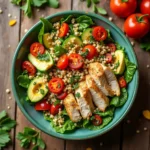Introduction
I still remember the first time I heard that “pepper lunch recipe“. It was late in the evening, and I had just finished a long day of exploring local markets in Tokyo. My feet were tired, but the aroma of grilled beef and warm rice pulled me into a small eatery where the cook served meals on scorching-hot plates. The sight was mesmerizing: thin slices of marinated beef arranged neatly over a bed of rice, corn sprinkled on top, and a generous pat of butter slowly melting in the center. A light drizzle of sauce brought it all together. That was my first experience with a Pepper Lunch meal, and it changed how I viewed quick yet satisfying food.
Growing up, I was surrounded by simple family dinners. Most nights, we stuck to comfort dishes like roast chicken or vegetable stew. We didn’t dine out often, so discovering a “sizzling plate” meal felt like stepping into a different kind of kitchen. Instead of the usual slow-simmered dishes, this was fast and bold—exactly what I had been missing.
Over the years, I tried many variations, some more authentic than others. But the core idea stayed the same: fresh ingredients, quick cooking, and a distinctive “peppery” aroma. I found myself craving this style of meal whenever I wanted something hearty that wasn’t complicated to make. It felt both casual and special, perfect for busy weekdays or relaxed weekends.

In this article, we’ll explore how to capture that magic right in your own home. I’ll share the essential ingredients, simple instructions, and a few tips I’ve picked up from my own cooking journeys. Prepare to bring those sizzling, savory scents into your kitchen. Once you master the basics, you can adapt and experiment—perhaps by adding different sauces or swapping in your favorite vegetables. The best part is that it all cooks quickly, so you can serve a hot, balanced plate without hours of work.
Before we move on to specifics, I hope this introduction gives you a glimpse of what Pepper Lunch can mean: a cozy meal with bold flavors that anyone can prepare. Now that you know a bit of my personal story, let’s look at how you can create your own version of this irresistible dish.
Table of Contents
Key Benefits
Fast and Convenient
Pepper Lunch offers a quick way to enjoy a complete meal. By using thinly sliced beef and pre-cooked rice (often Jasmine rice), you can finish cooking in minutes. This speed makes it perfect for busy days when you want something hearty but don’t have hours to spend in the kitchen. Everything comes together in a single pan or sizzling plate, so cleanup is a breeze.
Balanced and Satisfying
With protein, carbohydrates, and vegetables all in one dish, Beef Pepper Rice covers many nutritional needs. You get a protein source (usually beef), energy from rice, and vitamins from toppings like corn and green onions. Adding a small pat of butter and a splash of homemade sauce rounds out the flavor without too much complexity. This balance keeps you satisfied, reducing the urge to snack later.
Burst of Flavor
The combination of sizzling beef, fresh corn kernels, and black pepper creates an appealing aroma that draws you in as soon as you place the dish on the table. The hot plate sears the meat quickly, locking in natural juices. Meanwhile, a soy-based sauce deepens the taste without overpowering other ingredients. This approach delivers a layered flavor that feels both simple and comforting.
Adaptable Ingredients
While the traditional version uses beef, you can switch up the protein to suit your diet. Chicken, tofu, or thinly sliced pork are also popular. The main seasoning of salt, pepper, and soy sauce pairs well with many ingredients, making it easy to change the recipe based on your preferences or dietary needs. If you enjoy experimenting, add different vegetables like bell peppers or shiitake mushrooms for extra color and texture.
Minimal Kitchen Tools
You don’t need fancy equipment to make a Pepper Lunch Recipe at home. A sturdy cast-iron skillet or any heavy pan can replicate the sizzling effect. By keeping your tool list short, you can focus on what really matters—getting that tasty meal on the table and enjoying it while it’s still piping hot.
Ingredients
A Pepper Lunch meal features simple ingredients that you can easily find in most grocery stores. Freshness is key, especially for the beef and vegetables. Below, you’ll find a breakdown of the main components. Feel free to adjust quantities based on your taste or serving size.
Core Components
- Beef (8–10 ounces total)
- Thinly sliced beef is the heart of this recipe. Many people prefer sirloin or ribeye because of their marbling and tenderness. If you cannot find pre-sliced beef, choose a cut with some fat for flavor, then slice it yourself as thin as possible.
- Cooked Rice (2 cups)
- Use Jasmine rice or Japanese short-grain rice for the best texture. You want rice that’s slightly sticky but not mushy. If you have leftover rice from the day before, this dish is a great way to use it.
- Corn Kernels (½ cup)
- Canned or frozen corn works fine. Drain canned corn well, or defrost frozen corn beforehand to remove extra moisture. The slight sweetness of corn contrasts nicely with the savory taste of the beef.
- Butter (1 tablespoon)
- Even a small spoonful of butter adds a creamy finish to the final dish. If you avoid dairy, you can skip this ingredient or replace it with a plant-based option.
- Green Onions (2–3 stalks)
- Fresh scallions, sliced thinly, bring color and a hint of sharp flavor. Reserve some for garnishing at the end.
- Cooking Oil (1–2 tablespoons)
- Neutral-flavored oils like vegetable or canola work best. This oil is used to prevent sticking and to help sear the beef quickly.
Key Seasonings
- Black Pepper (1 teaspoon or more, to taste)
- Freshly ground black pepper is essential. Its pungent kick defines this dish and balances the richness of the other ingredients.
- Salt (½ teaspoon or to taste)
- A little salt helps draw out the beef’s natural juices. Adjust to your liking, but remember that soy sauce will contribute additional saltiness.
- Soy Sauce (2–3 tablespoons)
- A classic base for many Japanese-style sauces. It gives depth to the overall flavor. Choose a regular variety for a more robust taste, or a low-sodium type if you prefer a lighter option.
- Minced Garlic (1–2 cloves)
- Garlic adds a savory aroma that complements the beef and pepper. You can reduce or increase the amount depending on personal preference.
Optional Add-Ons
- Homemade Pepper Lunch Sauce
- Some cooks prepare a blend of soy sauce, mirin (or a sweetener), and a bit of garlic for extra flavor. You can drizzle it on top just before serving.
- Vegetables
- Sliced bell peppers, onions, or mushrooms can add variety to the dish. These extras help you incorporate more color and nutrition without significantly changing the cooking method.
- Alternative Proteins
- If you don’t eat beef, consider chicken breast or pork loin cutlets. Both work well with the same seasoning and cooking approach.
- Additional Toppings
- Extra scallions, sesame seeds, or chili flakes can boost flavor and visual appeal.
Why These Ingredients Work
- Beef and Rice form the base, providing protein and energy.
- Corn and Butter offer a sweet and creamy element that contrasts with the peppery finish.
- Soy Sauce and Garlic layer the meal with umami undertones, creating a mouthwatering aroma.
- Black Pepper stands out as a defining spice, giving the dish its signature kick.
- Green Onions and optional vegetables give the meal a fresh, crisp bite.
Every ingredient plays a part in creating the sizzling spectacle and bold taste Pepper Lunch is known for. Once you have these on hand, you’re ready to move on to the cooking process.

Instructions
Crafting a Pepper Lunch meal at home is simpler than it might appear. This approach involves minimal steps, and the cooking phase is short, which keeps the meat juicy and the rice fluffy. A heavy-bottomed cast iron pan (or any sturdy skillet) helps achieve that signature sizzle, but a standard nonstick pan can also work. Follow these clear steps:
Step 1: Prepare Your Cooking Surface
- Heat the Pan or Skillet
- Place your pan on medium-high heat and let it warm up for at least two minutes. The goal is to create a hot surface that will sear the beef and rice immediately.
- If you’re using a cast iron skillet, allow it a bit more time to reach a steady temperature.
- Add Oil
- Drizzle in one to two tablespoons of neutral cooking oil, such as canola or vegetable oil. The oil should start to shimmer slightly, indicating it is hot enough.
Step 2: Sear the Beef
- Season and Arrange
- Sprinkle both sides of the beef slices with salt and black pepper. Feel free to add a bit of garlic powder if you like an extra kick.
- Gently place the slices in a single layer on the heated pan. Avoid crowding the pan; sear in batches if needed.
- Cook Quickly
- Allow each side of the beef to cook for about 30–45 seconds. Thin slices brown fast, so keep an eye on them to prevent overcooking.
- Remove the beef from the pan once it has browned on both sides. Transfer it to a plate and cover lightly to keep it warm.
Step 3: Stir-Fry the Rice and Corn
- Add Rice
- With the heat still on medium-high, add your cooked rice to the pan. Spread it in a thin, even layer so the grains make contact with the hot surface.
- If the pan appears dry, add another drizzle of oil or a small knob of butter for added richness.
- Toss in the Corn
- Stir the rice with a spatula or wooden spoon, then add the corn kernels. Continue cooking for 1–2 minutes, letting the corn heat through and the rice develop a slightly crisp texture at the edges.
- Season Lightly
- Lightly season with salt and freshly ground pepper, adjusting the amounts to suit your preference. Keep stirring to prevent sticking.
Step 4: Combine and Flavor
- Reintroduce the Beef
- Return the seared beef to the pan. Stir it gently with the rice and corn to combine.
- If you have any pan juices left on the plate where the beef rested, pour them back in. They contain plenty of flavor.
- Add the Sauce
- Drizzle soy sauce over the mixture. A couple of tablespoons usually suffice, but adjust based on personal preference.
- Toss everything together for 30 seconds, ensuring the soy sauce coats both the rice and the beef. You can also add minced garlic at this stage if you want a stronger garlic essence.
- Butter and Final Seasoning
- Place a small pat of butter in the center of the pan and let it melt. Then, mix it through the rice and beef for a creamy finish.
- Taste the dish and add more black pepper or salt as needed.
Step 5: Garnish and Serve
- Top with Green Onions
- Scatter sliced green onions over the dish. This step brightens the meal with freshness and a bit of crunch.
- Plate It Up
- If you own a sizzling plate, heat it separately in the oven or on another burner. Carefully transfer the Pepper Lunch mixture onto the hot plate for that dramatic sizzle. Otherwise, serve it directly from your skillet.
- Optional Extras
- For those who crave a touch more heat, sprinkle chili flakes or drizzle a bit of spicy sauce. You can also serve additional soy sauce or a homemade Pepper Lunch sauce on the side.
These steps ensure you get the full Pepper Lunch experience in your own kitchen. Make sure to maintain a good level of heat throughout to keep everything sizzling. With your rice browned just right and your beef locked with flavor, you’ll be able to savor that savory aroma the moment it hits the plate.
Pro Tips and Variations
Pepper Lunch adapts well to different tastes and kitchen setups. Whether you’re looking to speed up your prep or explore new flavors, these tips and variations can help you make a truly satisfying meal.
Pro Tips
- Chill the Beef for Easy Slicing:
Partially freeze your beef for about 20 minutes before slicing. This firming technique makes the meat easier to cut thinly, ensuring it cooks quickly and evenly. - Use a Preheated Cast-Iron Skillet:
A cast-iron skillet retains heat exceptionally well. Ensure it’s properly preheated so the beef and rice sizzle immediately upon contact. This method locks in flavor and creates the signature searing effect. - Leverage Leftover Rice:
Day-old rice works best for stir-frying. It has a firmer texture that absorbs sauces without becoming mushy, enhancing both flavor and crunch. - Prepare All Ingredients in Advance:
Organize your workspace by chopping vegetables and measuring spices before you start cooking. Having everything ready minimizes cooking time and helps maintain consistent heat. - Monitor and Adjust the Heat:
Keep the heat steady at medium-high. Adjust the flame as needed to avoid burning the rice or overcooking the beef. A controlled temperature produces the desired crispy edges while keeping the meat tender. - Deglaze for Extra Flavor:
After searing the beef, deglaze the pan by adding a small splash of soy sauce or water. This step lifts the browned bits off the pan and incorporates them into your dish for a richer, umami taste. - Taste and Adjust as You Go:
Sample the dish during cooking. Gradually adjust the seasoning to reach a balanced flavor profile. This ongoing process helps prevent the dish from becoming too salty or bland.
Variations
- Alternate Proteins:
Although beef is traditional, you can easily substitute chicken breast, pork loin, or tofu. Use the same marinating and searing techniques to maintain the dish’s texture and flavor. - Vegetable Boost:
Add vegetables like bell peppers, mushrooms, or onions for extra color and nutrition. These ingredients bring new textures and flavors to the meal without altering the cooking process significantly. - Spicy Variation:
For those who enjoy a kick, introduce a few chili flakes or a dash of hot sauce when combining the ingredients. This subtle addition enhances the peppery notes and livens up the overall taste. - Herbal Infusion:
Incorporate fresh herbs like basil or cilantro just before serving. These herbs add a burst of freshness and a fragrant layer that complements the savory components. - Custom Sauce Enhancements:
Experiment with your sauce by adding a bit of mirin or a natural sweetener such as honey to the soy sauce. This modification creates a balanced sweetness that offsets the saltiness and pepper kick. - Alternate Grains:
Instead of Jasmine rice, try brown rice or quinoa for a different texture and added nutritional benefits. These grains bring a unique twist to the traditional dish while keeping the core flavors intact. - Creative Garnishes:
Enhance the visual appeal and flavor by topping the dish with toasted sesame seeds, a squeeze of lime, or extra sliced green onions. These finishing touches add a subtle tang or crunch that brightens up each bite. - Meal Prep Options:
If you’re cooking for multiple meals, store the beef and rice separately in airtight containers. When reheating, combine them in a hot skillet with a splash of water or broth to restore moisture and texture. - Seasonal Tweaks:
Incorporate seasonal vegetables such as zucchini during summer or carrots in winter. Adjust cooking times slightly to ensure they remain crisp and enhance the overall flavor profile. - Adjusting Portions:
Scale the recipe to suit your needs. Increase the sauce and spice quantities when cooking for a crowd, or reduce them for a single serving. This flexibility makes the dish ideal for both casual dinners and larger gatherings. - Try our pepper lunch recipe featuring sizzling beef, aromatic rice & fresh veggies. For food safety info, visit https://www.fsis.usda.gov/food-safety.
These pro tips and variations empower you to refine your Pepper Lunch recipe. Experiment with different ingredients and techniques until you find the combination that best suits your taste. Enjoy the process of personalizing the dish and making it uniquely yours.

Serving Suggestions
Presenting your Pepper Lunch dish in an appealing way enhances both the taste and dining experience. Here are several ideas to showcase your sizzling creation:
- Sizzling Plate Presentation:
- If available, transfer your hot mix of beef, rice, and vegetables to a preheated sizzling plate. This keeps the dish warm and maintains that signature sound and aroma.
- Serve directly from the sizzling plate to preserve the energy of the dish right up to the last bite.
- Eye-Catching Garnishes:
- Top your meal with freshly sliced green onions for color and a burst of mild sharpness.
- A light sprinkle of toasted sesame seeds adds a subtle nutty note and elevates the presentation.
- A squeeze of lime over the top can add a hint of brightness, balancing the savory flavors.
- Complementary Side Dishes:
- Serve a simple side salad with mixed greens dressed lightly in a tangy vinaigrette. The crispness of fresh vegetables provides a refreshing contrast to the warm, hearty main dish.
- Consider pairing the meal with steamed or stir-fried seasonal vegetables like broccoli, snap peas, or bell peppers. These add vibrant color and additional nutrients without overwhelming the primary flavors.
- Beverage Pairings:
- A chilled glass of iced green tea or citrus-infused water works well, offering a refreshing contrast to the rich flavors.
- For those who enjoy a bit of alcohol, a crisp white wine or a light beer can complement the dish without overpowering its taste.
- Plating and Presentation Tips:
- Use a clean, bright plate that allows the colors of the ingredients to stand out.
- Keep your presentation simple to let the ingredients shine—focus on neatness and balance.
- Consider adding a small bowl of extra homemade sauce on the side for those who enjoy a richer flavor experience.
These serving suggestions are designed to enhance the visual and taste experience of your Pepper Lunch recipe. Whether you prefer a classic sizzling display or a refined plated presentation, these ideas help bring out the best in every element of your dish.
Conclusion
This Pepper Lunch recipe offers a fast, balanced meal that delivers bold flavors on a sizzling plate. The recipe combines tender beef, perfectly cooked rice, and crisp vegetables in a straightforward process. Each step—from preparing ingredients to the final presentation—ensures that you enjoy a meal that is both satisfying and simple to make.
By following these clear instructions, you can recreate the signature taste of a Pepper Lunch dish in your own kitchen. The method preserves the natural flavors of the beef and rice while adding a distinct peppery kick that makes every bite memorable. This dish is ideal for busy weeknights and casual get-togethers, offering a complete meal that is easy to prepare and delightful to eat.
Remember, the key is to keep the process simple. Use fresh ingredients, control the heat to maintain a good sizzle, and adjust the seasonings gradually. This approach not only preserves the flavor but also allows you to tailor the dish to your personal taste. Enjoy experimenting with different proteins, vegetables, and garnishes until you create your perfect version of Pepper Lunch.
This recipe is more than a meal—it is an invitation to explore a new way of cooking that is both efficient and full of flavor. Enjoy the process and savor the results with every sizzling, savory bite.
FAQs
How can I recreate a Pepper Lunch dish at home?
Begin by gathering all your components and heating a heavy skillet over medium-high. Sear thin slices of beef quickly, then stir in your pre-cooked rice and corn kernels. Return the beef to the pan, add a drizzle of soy sauce and a small knob of butter, and finish with chopped green onions. Serve immediately to capture that signature sizzle.
Which ingredients are essential for this Pepper Lunch dish?
You will need:
- Thinly sliced beef (sirloin or ribeye are excellent choices)
- Cooked Jasmine or Japanese short-grain rice
- Corn kernels
- Butter
- Green onions
- A neutral oil (such as vegetable or canola)
- Salt and freshly ground pepper
- Soy sauce
- Minced garlic
Optional extras include additional vegetables and garnishes to suit your taste.
Which beef cuts offer the best texture and taste?
Cuts like sirloin or ribeye, celebrated for their tenderness and marbling, work best. For easier slicing, chill the beef for a short period before cutting it into thin pieces.
What is the total preparation and cooking time?
This dish generally takes about 20 to 30 minutes from start to finish, making it an ideal option for a quick, satisfying meal.
What pitfalls should I steer clear of when making Pepper Lunch at home?
- Ensure your pan has enough space to maintain a high temperature for an effective sear.
- Preheat your skillet thoroughly before adding ingredients.
- Keep a close eye on the beef to avoid overcooking.
- Introduce seasonings gradually and taste as you go.
- Prepare all your ingredients beforehand for a smooth cooking process.




